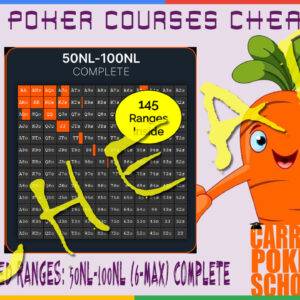What is PLOTheory Advanced PLO Theory Volume 2 by Tom Chambers for Cheap?
Volume 2: Six-Max Strategy (547 pages) is a comprehensive analysis of six-handed pot-limit omaha.
It begins with Chapter 7: Starting Hand Charts, which includes a methodology for categorizing starting hands and a series of charts presenting those cateogories.
This chapter contains charts that categorize PLO starting hands. The basis for the categories is a power rating and two character ratings – polarity and nuttiness, The power rating is derived from the flopped-hand-strength ratings from Chapter 4 (Module 4C). Every hand is rated based on its total strength across all its possible flops.
The polarity rating indicates whether most of a hand’s value comes from hitting a few flops very hard or hitting many flops pretty well. The nuttiness rating indicates how likely the hand is to have the nuts.
Using the three ratings and baseline pairedness/suitedness groupings, similar hands are placed into categories, and data about the categories is presented in a series of charts.
Chapter 8: Advanced Board Texture applies a quantitative process to the analysis of flop texture, using the hand-board combinatorics work from Volume 1.
This chapter expands on the flop texture categories in Chapter 2. It applies a quantitative process to the analysis of flop texture, using the hand-board combinatorics work in Chapter 3 to classify boards both in terms of the number of available draws and interaction with different starting hand ranges.
It also includes a full analysis of hand strength distributions on every flop and discussion of typical play dynamics on different board types.
Chapter 9: Preflop Theory
This chapter presents a series of theory concepts that demonstrate how to use preflop decisions to encourage the most profitable postflop situations for different starting hand types.
It examines preflop decisions in the context of the situations they set up with reference to the seven key parameters of a postflop situation – number of opponents, position, stack-to-pot ratio, initiative, board texture, opponent tendencies, and image.
It includes an overview of decision making from different positions and versus different opponent types, including opening ranges, cold-calling and 3-betting ranges, and what to do facing 3-bets in and out of position.
Chapter 10: Flop Theory
This chapter separates the common postflop scenarios into sixteen situation classes.
It uses analysis of the seven parameters of postflop play to guide discussion of continuation betting, defending against continuation bets, stack-off ranges, leverage, bet-sizing, bluffing, and semi-bluffing.
The primary goal of Chapter 10 is to learn to analyze flop decisions within the context of developing a multi-street plan to deal with turn and river contingencies.
Chapter 11: Turn Theory
This chapter continues Chapter 10’s emphasis on multi-street planning with an emphasis on flop-turn transition lines such as double barrel bluffs and semi-bluffs, floats, and delayed continuations betting.
It includes a detailed analysis of turn texture that builds from the flop texture analysis in Chapters 2 and 8 and is organized into several sections that cover different flop-turn texture shifts.
It also includes discussion of turn-river transition concepts which build from the two-street games studied in Chapters 5 and 6.
Chapter 12: River Theory, which include most of the longest chapters in the book, each cover play on a different street.
This chapter examines the significance of the fact that on the river hand values are static (no more semi-bluffing) and options are limited (no more multi-street contingency plans).
A major component of the chapter is a series of hand-reading case studies which demonstrate how to use the theoretical framework from Volume 1 along with previous actions and game dynamic to deconstruct our range and our opponent’s.
It also includes a section reviewing game theory concepts which show how to use that information to determine value-betting, bluffing, and bluff-catching frequencies and ranges.
For details on each chapter and descriptions of their modules, click on the respective link above.
LOTheory Advanced PLO Theory Volume 2 is available as part of a full book purchase ($2,500) or individually for $1,500.
These chapters establish the theoretical infrastructure needed for Volume 2: Six-Max Strategy, which includes a complete analysis of online six-handed games.









Reviews
There are no reviews yet.